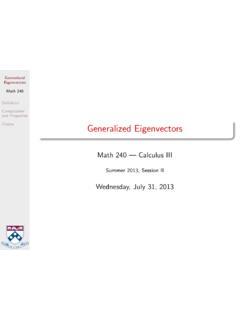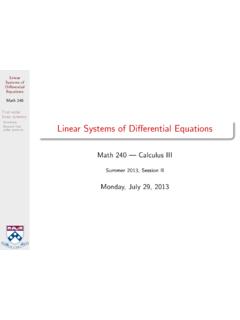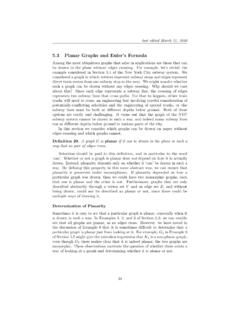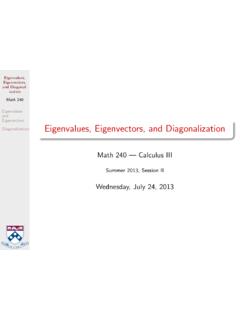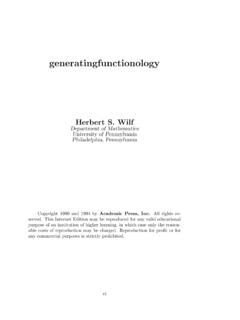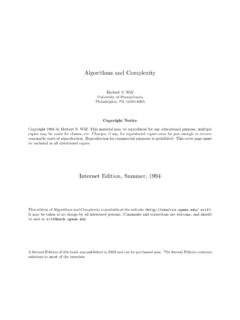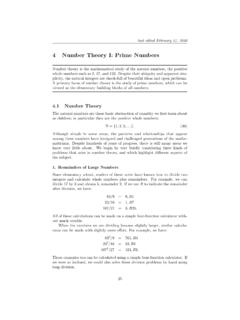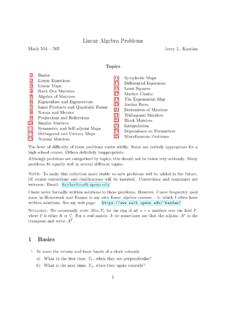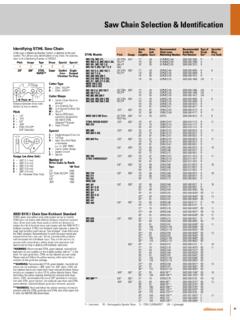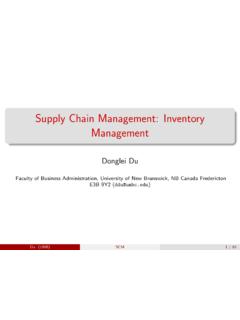Transcription of 11 Partial derivatives and multivariable chain rule
1 11 Partial derivatives and multivariable chain Basic defintions and the Increment TheoremOne thing I would like to point out is that you ve been taking Partial derivativesall your calculus-life. When you computedf/dtforf(t)=Ce kt, you get Cke ktbecauseCandkare constants. The notationdf/dttells you thattis the variablesand everything else you see is a constant. If we use the notationf0instead, then weare relying on your knowing which is the independent variable. It s usually calledsomething like t , not C or k , but every now and then we end up computingdf/dkordf/dC, so watch out! The only rule is: everyone should understand whichis the independent now, studying Partial derivatives , the only di erence is that the other variablesaren t constants they vary but you treat them as constants anyway. It s not a bigdi erence because really, what is a constant? It s always possible to imagine somequantity changing.
2 Mathematically we just need to be precise about what is holdingsteady and what is changing. In this section, only one variable at a time will in the next section ( chain rule), we ll change more than one independent variableat a time and keep track of the total e ect on the independent assigned plenty of MML problems on this section because the computations aren tmuch di erent than ones you are already very good at. You can read the basics inSection I will include one example as a self-check; if you are not able to coverup the answer and figure it out pretty easily, then you need to go back and re-readSection :Letf(x,t,q)=eq 11+xtq. What is@f@tat the point (3,1,1) and what doesthis quantity signify?Answer: treating everything other thantas a constant, by either the chainrule or the quotient rule you get xq(eq 1)/(1 +xtq)2. Evaluating atthe point (3,1,1) gives 3(e 1) means that iftis changes by a small amount from 1 whilexis heldfixed at 3 andqat 1, the value offwould change by roughly 3(e 1)/16times as much in the opposite Increment TheoremBy now I m sure you remember the linearization in one-variable.
3 The value off(x)near the pointx=ais well approximated byL(x)=f(a)+f0(a) (x a). Supposewe now want to approximatef(x,y)nearapoint(a,b) , in fact that we change onlyxbut noty. Then we might as well treatyasaconstantandwritef(x+ x,y)=f(x,y)+( x) @ s a Partial derivative, not a total derivative, because there is another variableywhich is being held fixed. Similarly, if we moved onlyywe would havef(x,y+ y)=f(x,y)+( y) @ tseemliketoomuchofaleaptosaythatifyoumov ebothxandyyou ll get both of these e ects:f(x,y+ y)=f(x,y)+( x) @f@x(x,y)+( y) @ ( ) is called the Increment Theorem in the textbook and appears asTheorem 3 on page 818 (Section ). You might wonder whether it s OK to assumethat you can just add the two e ects from movingxand movingy. In fact, after youmovex, you really should be computing theyincrement according to the@f/@yatthe new location, (x+ x,y). However, it s only an approximntion anyway, and thenew Partial derivative is close enough to the old that the computation with the newpartial derivative matches the computation with the old Partial derivative to withinthe error you already introduce by :About how much doesx2/(1 +y)changeif(x,y)changesfrom(10,4)to (11,3)?
4 Here x=1and y= 1. We computefx=2x/(1 +y)andfy= x2/(1 +y)2so sofx(10,4) = 4 andfy(10,4) = 4. Thus, f fx x+fy y=4(1)+( 4)( 1) = fact,fchanges from 20 to so the 8 was kind of a crude estimate, but that sbecause xand ywere pretty big. If we choose ,wegetalinear estimate of f= : marginal ratesSuppose the cost of a proposed building is a functionf(A,q,`)whereAis the areaof usable space in square feet,qis an index of the quality (thickness of walls, gaugeof wiring, level of insulation, quantity of lighting, etc.) and`is a location param-eter measuring, for example, the desirability of the location. The average cost persquare foot for a given proposed building is, by definition,f(A,q,`)/A. However,this statistic is far less useful than themarginalcost per square foot, that is,@ s because most decisions are about whether to put a few extra dollars into oneof these categories or to trim a few bucks from another category.
5 Therefore, it is mostuseful to know how many dollars more you will spend or save with each square foot,rather than what all the square footage costs that is already in all the proposals :The total numberPof people exposed to an recurring ad is a function ofits market share,M, and the length of time,t, that stays in rotation5. The marginalincrease in exposure per time run is@ The right time to yank the ad is whenv @f/@tdrops below the cost per time to run the ad, wherevis the value in dollarsper unit of exposure. Note that the units match:vhas units of dollars per exposure,@f/@thas units of exposure per time and the cost to run the ad is priced in dollarsper time: ($/exp) (exp/t) = $ : the notion of marginal rates should already be familiar from univariate isn t much added here, except to say that it makes sense to compute marginalrates when there are many quantities that could vary, by varying only diagramsIn applications, computing Partial derivatives is often easier than knowing what par-tial derivatives to compute.
6 With all these variables flying around, we need a way ofwriting down what depends on what. We do this by writing a branch diagram. Hereare some common is not just the product of these because the longer it runs, the more redundancy there is inpeople seeing it multiple branch diagramfor the ordinarychain a function ofxandy, both of whichare functions of a sin-gle variablet(seepage 823 of the text-book).fyxzdepends onxandybutyisreally a func-tion ofxywzxwis a function ofx,yandz,butzisreally a function ofthe other variable at the top is an dependent variable. Any variable at the bottom isan independent variable; these drive the other variables and are the only ones wetweak directly. The variables in the middle are calledintermediatevariables. Theindependent variables drive them and they drive the dependent chain ruleThink about the ordinary chain rule. A useful metaphor is that it is like a gearassembly6:ydepends onu, which in turn depends onx.
7 Each unit increase ofxincreasesubyu0(x)manyunits. Eachunitincreaseofuinceasesybyy0(u) each unit increase inxproducesu0(x) y0(u)unitsincreaseiny. That swhat s going on in the first branch the second diagram, there is a single independent indpendent variablet, which wethink of as a gear driving bothxandy, while now to explain whydydt=@y@ududt+@ you got me, that s a simile not a by t,bothuandvincrease. The increases are roughly ( t)(du/dt)and ( t)(dv/dt) respectively. As we just saw at the end of the previous section (withthe functionz(x,y)) each increase inuproduces an increase inythat is@y/@utimesas great. So the increase inuof tdudtgives gives an increase inyof roughly tdudt@ the increase inthas produced an increase invwhich produces anotherincrease inyof roughly tdvdt@ Thus the total increase inyis roughly t @y@ududt+@y@vdvdt .This means that the rate of change ofyper change intis given by equation ( ).
8 Note that we use Partial derivative notation for derivatives ofywith respect touandv,asbothuandvvary, but we use total derivative notation for derivatives ofuandvwith respect totbecause each is a function of only the one variable; we also use totalderivative notationdy/dtrather than@ Do you see why? Partial derivativenotation would mean thattwas changing while something else was being held fixed,which is not the case. Rather, all variables are functions of the single s the basic story. There are lots of variations, depending on how many in-dependent variables there are (up till now there has been only one, all the othersultiimately being functions of the one), how many intermediate variables and howthey are to evaluate?The one thing you need to be careful about is evaluating all derivatives in the rightplace. It s just like the ordinary chain rule. For example, in ( ), the derivativesdu/dtanddv/dtare evaluated at some timet0.
9 The Partial derivative@y/@uisevaluated atu(t0)andthepartialderivative@y/@vis evaluated atv(t0).Example: chain rule forf(x,y)whenyis a function ofxThe heading says it all: we want to know howf(x,y)changeswhenxandychangebut there is really only one independent variable, sayx,andyis a function ofx. This105is captured by the third of the four branch diagrams on the previous page. Applyingthe chain rule givesdfdx=@f@x+@f@y y0.( )The notation really makes a di erence here. Bothdf/dxand@f/@xappear in theequation and they are not the same thing!Derivative along an explicitly parametrized curveOne common application of the multivariate chain rule is when a point varies alongacurveorsurfaceandyouneedtofigureth erateofchangeofsomefunctionofthemoving point. The classical economics application is that price and quantity are mov-ing together along thedemand curveand we want to figure out how revenue changesalong this curve (and in particular, we want to find where the revenue is maximized).
10 In this section we solve the problem when the curve is known explicitly, saving thecase of implicitly defined curves until we have discussed implicit di a point varies along a curve as a function of time, and its coordinates areexplicitly known: the coordinates at timetare (x(t),y(t)). The rate of change of thefunctiong(x,y)withrespecttotimealong the curve is given by the formula we justcomputed:xandyare functions oftandgis a function ofxandy, sodgdt=@g@xdxdt+@ ofy,andxandyin place Implicit di erentiationThe chain rule helps us to understand ordinary implicit di erentiation. In Section page 826 the textbook re-explains finding the slope of an implicitly defined curve(first discussed in the textbook in Section ). Here follows a quick recap of of an implicitly defined curveSuppose a curve is defined byF(x,y) = 0. What is the slope of its tangent line?That s the same as asking, if we treatyas a function ofxalong the curve, what isdy/dx?
